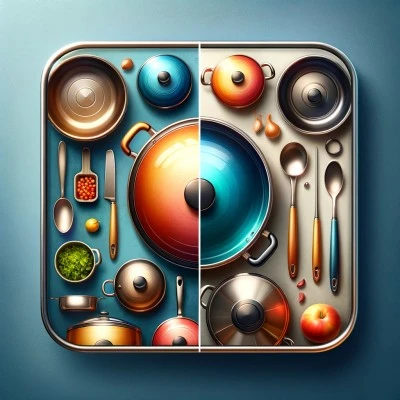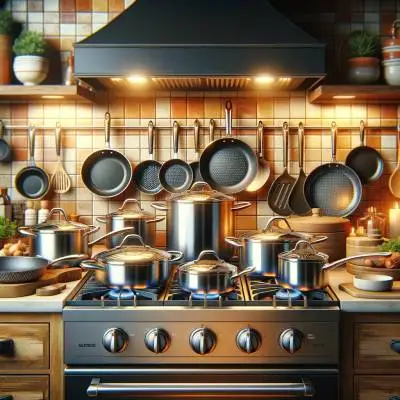Master Your Kitchen: Ceramic vs Stainless Steel Cookware Compared
Exploring the world of cookware, two materials often stand at the forefront of kitchen choices: ceramic and stainless steel. Each offers unique benefits and drawbacks, influencing cooking performance, durability, and health considerations. This comparison aims to guide home chefs and cooking enthusiasts in understanding the differences between these popular materials, aiding in making informed decisions for their culinary needs and preferences.
This page contains affiliate links. If you make a purchase after clicking on one of these links, we may receive a commission at no cost to you.
I. Introduction to Ceramic vs Stainless Steel Cookware
The kitchen, often considered the heart of the home, is where cookware materials play a pivotal role. Among the plethora of options available, ceramic and stainless steel cookware stand out for their distinct qualities and functionalities. This article delves into the nuances of these two popular materials, offering a comprehensive understanding of how they can impact your culinary experience.
A. Overview of Ceramic Cookware
Ceramic cookware, known for its classic appeal, is made either entirely of ceramic or has a metal body coated with a ceramic layer. This type of cookware is celebrated for its health benefits, as it is usually free of PTFE (Polytetrafluoroethylene) and PFOA (Perfluorooctanoic Acid), chemicals often found in non-stick coatings. Ceramic cookware distributes heat evenly, making it ideal for slow cooking and ensuring well-cooked meals with minimal risk of burning.
B. Overview of Stainless Steel Cookware
In contrast, stainless steel cookware is revered for its durability and robustness. Made from an alloy of steel, chromium, and often nickel, it’s known for its resistance to rust and corrosion. While it does not inherently possess non-stick properties, its high heat tolerance and non-reactive nature make it a preferred choice for searing, browning, and sautéing.
C. Importance of Material Choice in Cooking
The material of your cookware can significantly influence the taste, nutritional value, and overall quality of your food. It also plays a crucial role in the cookware’s maintenance, longevity, and suitability for different cooking methods. Understanding these aspects is crucial for both amateur cooks and seasoned chefs alike.
II. Comparison of Ceramic and Stainless Steel Cookware
A. Heat Conductivity and Distribution
Ceramic cookware excels in providing even heat distribution, reducing the likelihood of hot spots, and ensuring consistent cooking. However, it may take longer to heat up. Stainless steel cookware, often combined with a core of aluminum or copper, offers excellent heat conductivity, allowing for quick heating and precise temperature control.
B. Durability and Lifespan
While ceramic cookware is robust in heat distribution, it can be prone to chipping or cracking over time. It requires careful handling and maintenance. Stainless steel, on the other hand, boasts remarkable durability. It withstands high temperatures and resists scratches and dents, making it a long-lasting addition to any kitchen.
C. Health and Safety Aspects
Ceramic cookware is often lauded as a safer choice, particularly when it comes to chemical-free cooking surfaces. On the other hand, stainless steel cookware is inert and does not leach metals or chemicals into food, provided it’s used and maintained correctly.
D. Ease of Cleaning and Maintenance
Both ceramic and stainless steel cookware have their advantages in cleaning. Ceramic’s smooth surface makes it relatively easy to clean, though it requires gentle handling to avoid damage. Stainless steel is more forgiving and can typically withstand harsher scrubbing and dishwasher use.
E. Aesthetic and Design Variations
Ceramic cookware comes in a variety of colors and designs, adding a decorative touch to the kitchen. Stainless steel’s sleek and timeless appearance makes it professional and modern, easily fitting into any kitchen aesthetic.
F. Cost Considerations
Generally, high-quality ceramic cookware can be more expensive due to its chemical-free composition and aesthetic appeal. Stainless steel cookware ranges widely in price, depending on the quality and brand, but can be a more budget-friendly option in the long term due to its durability.
III. Advantages of Ceramic Cookware
A. Non-Reactive Nature
Ceramic cookware is non-reactive, meaning it won’t alter the flavor of acidic foods like tomatoes or lemons. This ensures the purity of your dish’s flavors.
B. Non-Stick Properties
Many ceramic cookware pieces have natural, non-stick surfaces, reducing the need for excessive oil or butter, which is ideal for health-conscious cooking.
C. Environmental Friendliness
Ceramic cookware is often made from natural, sustainable materials, making it an eco-friendly choice for those looking to reduce their environmental footprint.
IV. Advantages of Stainless Steel Cookware
A. Superior Heat Retention
Stainless steel cookware excels in retaining heat, which is essential for searing meats and maintaining the temperature of your dishes throughout the cooking process.
B. Versatility in Cooking Methods
This type of cookware is suitable for a wide range of cooking methods, from stovetop to oven, and is even induction-compatible, making it a versatile tool in any kitchen.
C. Long-Term Durability
The strength and resistance to wear and tear make stainless steel cookware a worthy investment. It is capable of withstanding years of frequent use.
V. Choosing the Right Cookware for Your Needs
A. Assessing Cooking Habits and Preferences
Consider your cooking style and what you most often cook. If you prefer slow-cooked, evenly heated dishes, ceramic might be your go-to. For high-heat cooking and versatility, stainless steel could be more suitable.
B. Balancing Budget and Quality
While initial cost is an important factor, also consider the long-term value. Investing in high-quality cookware can save money over time, reducing the need for replacements.
C. Considering Kitchen Space and Compatibility
Assess your kitchen space and compatibility with your stove type. Some cookware is better suited for certain stovetops, and the size and number of pieces should fit comfortably in your storage space.
VI. FAQs
Q: Is ceramic cookware safer than stainless steel in terms of chemical exposure?
A: Ceramic cookware is often favored because it is free of chemicals like PTFE and PFOA, making it a safer choice for those concerned about chemical exposure. Stainless steel is also considered safe, as it is non-reactive and doesn’t release toxins at high temperatures.
Q: Can I use metal utensils with ceramic and stainless steel cookware?
A: It is not recommended to use metal utensils with ceramic cookware as they can scratch and damage the non-stick surface. Stainless steel cookware, however, can typically withstand the use of metal utensils without damage.
Q: Are ceramic and stainless steel cookware dishwasher safe?
A: Most stainless steel cookware is dishwasher safe. However, ceramic cookware, especially ceramic-coated cookware, should be washed by hand to extend its lifespan, as the dishwasher can wear down the non-stick coating.
Q: Can stainless steel cookware be used on induction cooktops?
A: Stainless steel cookware with a magnetic outer layer is compatible with induction cooktops. Pure stainless steel without this feature cannot be used on induction stovetops.
Q: What should I do to prevent food from sticking to stainless steel cookware?
A: To minimize sticking, it’s recommended to preheat the stainless steel pan and use enough oil or fat. Also, allowing food to sear properly before flipping can help prevent sticking.
Q: Can ceramic frying pans handle high-heat cooking?
A: Ceramic frying pans are suitable for low- to medium-heat cooking. They are not ideal for high-heat methods like searing, as extreme temperatures can damage the non-stick coating.
Q: Is stainless steel cookware safe?
A: Yes, stainless steel cookware is safe. It is non-reactive and does not leach metals or chemicals into food, making it a healthy choice for cooking.
VII. Conclusion
A. Summary of Key Points
In this comprehensive look at ceramic vs stainless steel cookware, we’ve explored the distinct characteristics of both materials. Ceramic cookware is known for its chemical-free, non-stick surface, and even heat distribution. At the same time, stainless steel stands out for its durability, versatility in cooking methods, and superior heat retention. The choice between the two largely depends on individual cooking styles, preferences, and health considerations.
B. Final Recommendations
For those prioritizing health and easy clean-up, ceramic cookware is an excellent choice. However, if you seek durability and versatility in high-heat cooking methods, stainless steel is the better option. Both types of cookware have their unique advantages, making them valuable additions to any kitchen.
VIII. Suggested Readings
These books offer a wealth of knowledge for cooks, both novices and experienced, who want to enhance their understanding of cookware materials, cooking techniques, and the science behind culinary art.
- “Cookware and Bakeware” by David J. Rutledge – A comprehensive guide exploring various materials used in cookware and bakeware, offering insights into their properties and best uses in the kitchen.
- “The Science of Cooking: Understanding the Biology and Chemistry Behind Food and Cooking” by Joseph J. Provost – This book delves into the scientific principles behind cooking, including the impact of different cookware materials on food.
- “Cooking for Geeks: Real Science, Great Hacks, and Good Food” by Jeff Potter – A unique blend of science, cooking, and practical advice, this book includes a section on choosing the right cookware for different cooking methods.
- “The New Cast Iron Skillet Cookbook: 150 Fresh Ideas for America’s Favorite Pan” by Ellen Brown – While focusing on cast iron, this book offers valuable comparisons with other cookware types, including ceramic and stainless steel.
- “The Essential Home-Ground Flour Book: Learn Complete Milling and Baking Techniques” by Sue Becker – Alongside baking techniques, this book provides insights into the importance of choosing the right cookware for various culinary tasks.
Whether you’re a home chef or a culinary enthusiast, delving into these resources will enrich your cooking experience and help you make informed choices about your cookware.






